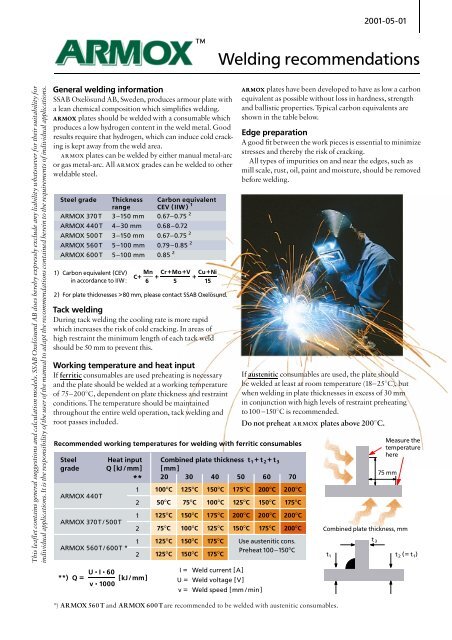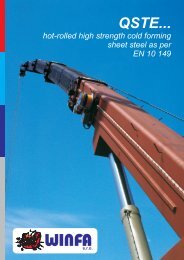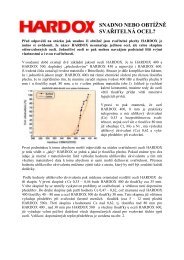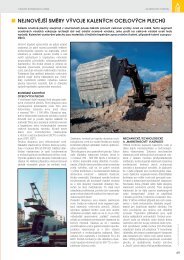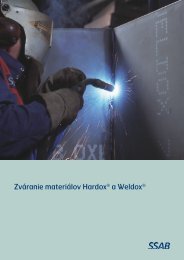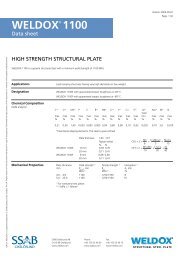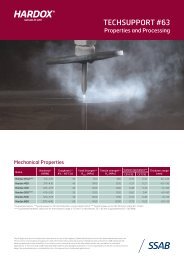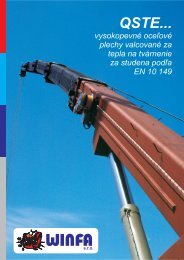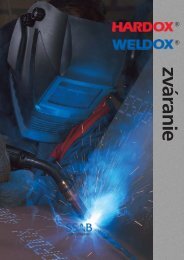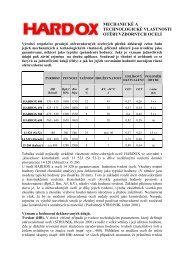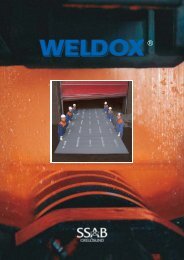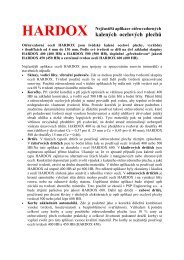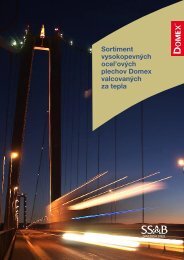Armox Steel Welding PDF
Armox Steel Welding PDF
Armox Steel Welding PDF
Create successful ePaper yourself
Turn your PDF publications into a flip-book with our unique Google optimized e-Paper software.
2001-05-01<br />
,<br />
<strong>Welding</strong> recommendations<br />
This leaflet contains general suggestions and calculation models. SSAB Oxel˛sund AB does hereby expressly exclude any liability whatsoever for their suitability for<br />
individual applications. It is the responsibility ofthe user ofthe manual to adapt the recommendations contained herein to the requirements of individual applications.<br />
General welding information<br />
SSAB Oxel˛sund AB, Sweden, produces armour plate with<br />
a lean chemical composition which simpli¢es welding.<br />
armox plates should be welded with a consumable which<br />
produces a low hydrogen content in the weld metal. Good<br />
results require that hydrogen, which can induce cold cracking<br />
is kept away from the weld area.<br />
armox plates can be welded by either manual metal-arc<br />
or gas metal-arc. All armox grades can be welded to other<br />
weldable steel.<br />
<strong>Steel</strong> grade Thickness Carbon equivalent<br />
range CEV ( IIW ) 1<br />
ARMOX 370 T 3^150 mm 0.67^0.75 2<br />
ARMOX 440 T 4^30 mm 0.68^0.72<br />
ARMOX 500 T 3^150 mm 0.67^0.75 2<br />
ARMOX 560 T 5^100 mm 0.79^0.85 2<br />
ARMOX 600T 5^100 mm 0.85 2<br />
1) Carbon equivalent (CEV)<br />
in accordance to IIW:<br />
2) For plate thicknesses †80 mm, please contact SSAB Oxel˛sund.<br />
Tack welding<br />
During tack welding the cooling rate is more rapid<br />
which increases the risk of cold cracking. In areas of<br />
high restraint the minimum length of each tack weld<br />
should be 50 mm to prevent this.<br />
Working temperature and heat input<br />
If ferritic consumables are used preheating is necessary<br />
and the plate should be welded at a working temperature<br />
of 75^200‡C, dependent on plate thickness and restraint<br />
conditions.The temperature should be maintained<br />
throughout the entire weld operation, tack welding and<br />
root passes included.<br />
<strong>Steel</strong> Heat input Combined plate thickness t 1 +t 2 +t 3<br />
grade Q [kJ /mm] [ mm ]<br />
** 20 30 40 50 60 70<br />
ARMOX 440T<br />
1 100‡C 125‡C 150‡C 175‡C 200‡C 200‡C<br />
2 50‡C 75‡C 100‡C 125‡C 150‡C 175‡C<br />
ARMOX 370T/500T<br />
ARMOX 560T/600T *<br />
**)Q = U à I à 60 [kJ/mm]<br />
v à 1000<br />
C+ Mn + Cr+Mo+V + Cu+Ni<br />
6 5 15<br />
Recommended working temperatures for welding with ferritic consumables<br />
1<br />
2<br />
1<br />
2<br />
125‡C 150‡C 175‡C 200‡C 200‡C 200‡C<br />
75‡C 100‡C 125‡C 150‡C 175‡C 200‡C<br />
125‡C 150‡C 175‡C Use austenitic cons.<br />
125‡C 150‡C 175‡C<br />
Preheat100^150‡C<br />
I = Weld current [A]<br />
U = Weld voltage [V]<br />
v= Weldspeed[mm/min]<br />
armox plates have been developed to have as low a carbon<br />
equivalent as possible without loss in hardness, strength<br />
and ballistic properties.Typical carbon equivalents are<br />
shown in the table below.<br />
Edge preparation<br />
A good ¢t between the work pieces is essential to minimize<br />
stresses and thereby the risk of cracking.<br />
All types of impurities on and near the edges, such as<br />
mill scale, rust, oil, paint and moisture, should be removed<br />
before welding.<br />
If austenitic consumables are used, the plate should<br />
be welded at least at room temperature (18^25‡C), but<br />
when welding in plate thicknesses in excess of 30 mm<br />
in conjunction with high levels of restraint preheating<br />
to100 ^150‡C is recommended.<br />
Do not preheat ARMOX plates above 200‡C.<br />
Measure the<br />
temperature<br />
here<br />
75 mm<br />
Combined plate thickness, mm<br />
t 3<br />
t 1 t 2 (= t 1 )<br />
*) ARMOX 560T and ARMOX 600Tare recommended to be welded with austenitic consumables.
<strong>Welding</strong> recommendations for ARMOX plate (cont.)<br />
Selection of consumables<br />
Consumables should be selected on the basis of strength<br />
and toughness requirements in the welded joint as well as<br />
on the prevailing restraint conditions.<br />
In order to achieve an optimum combination of strength<br />
and toughness in the welded joint , select a consumable<br />
with as lowest strength as possible, but which still ful¢ls<br />
the strength requirements for the joint. Overmatching<br />
should be avoided. Designers should attempt to position<br />
the welds in low stress areas. In most cases, undermatching<br />
consumables can then be used.The main advantages of a<br />
low-strength instead of a high-strength consumable are<br />
an increase in plastic deformation capacity (ductility), a<br />
reduced susceptibility to cracking and better toughness<br />
in the weld joint.<br />
Basic consumables are most suitable for armox plate.<br />
Consumable recommendations<br />
Handling of consumables<br />
Select the weld process and consumables which produce<br />
the lowest possible level of hydrogen in the weld metal.<br />
Covered electrodes should be thoroughly dried to ensure<br />
that the hydrogen content does not exceed 5 ml per100 g<br />
weld metal (the Hg method according to iso 3690).<br />
Consumables should be stored to ensure that moisture<br />
absorption is prevented. Always keep opened packages of<br />
electrodes dry and warm (at least125‡C).<br />
Do not return unconsumed electrodes to dry cabinets<br />
if there is the slightest risk that they may have absorbed<br />
moisture. (Harmful absorption can take place in 30 to 60<br />
minutes).<br />
If there is any risk that moisture has been absorbed, the<br />
consumable must be discarded or ask the manufacturer for<br />
advice on redrying. Precautions that apply to covered electrodes<br />
also apply in the main to granular £ux, and £uxcored<br />
wires.<br />
Manufacturer Austenitic consumables Ferritic consumables<br />
EN 1600 E 18 8 Mn<br />
EN 499 xxx H5<br />
AWS A /SFA 5.4-92 E 307-15 AWS: A 5.18-93 ER70S-6 E7018-1<br />
AWS A5.22 E 307 LT-2<br />
AWS: A 5.28-79ER80S-G<br />
ELECTRODES<br />
WIRES<br />
ESAB OK 67.45 OK 48.08, OK Femax 38.65<br />
OK 67.52 OK 55.00<br />
FILARC Filarc BM 307 Filarc 35<br />
Filarc 56 S<br />
OERLIKON COMET 307 Special<br />
SAFDRY R 307<br />
Supercord S<br />
THYSSEN THERMANIT X Phoenix 120 K<br />
SH Grˇn K52W<br />
ESAB OK Autrod 16.95 OK Autrod 12.51<br />
OK Tubrod 14.36 OK Tubrod 15.00<br />
FILARC Filarc PZ 6070 Filarc PZ 6000<br />
Filarc PZ 6470 Filarc PZ 6130<br />
OERLIKON NERTALIC 51 FLUXOFIL 40<br />
SAFDUAL 651 Carbofil 100<br />
THYSSEN THERMANIT X TG 50 B<br />
Union K52<br />
SSAB Oxel˛sund AB<br />
SE-613 80 OXELÚSUND, Sweden<br />
Tel. +46 155 25 40 00<br />
Fax +46 155 25 40 73<br />
www.oxelosund.ssab.se<br />
E-53 HELIN INFORMATION 2001-05


